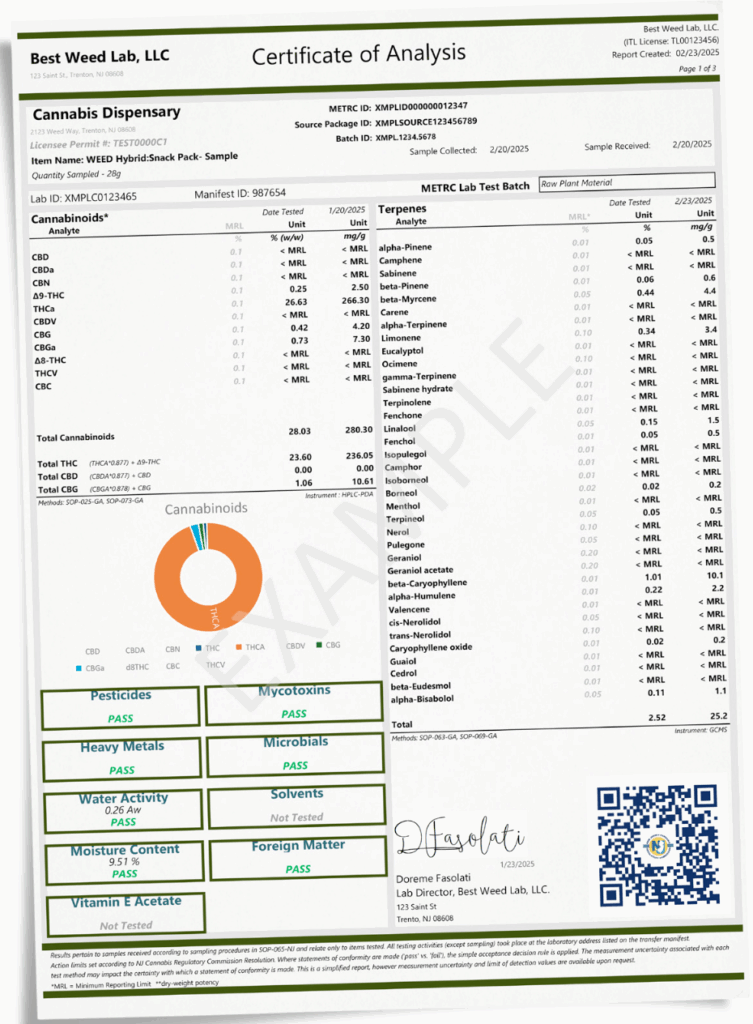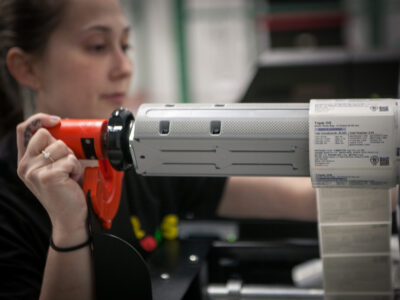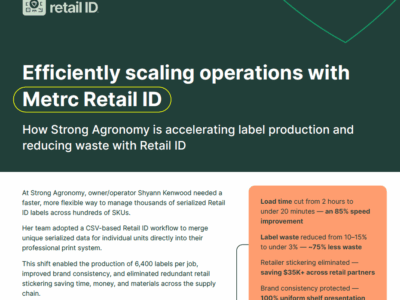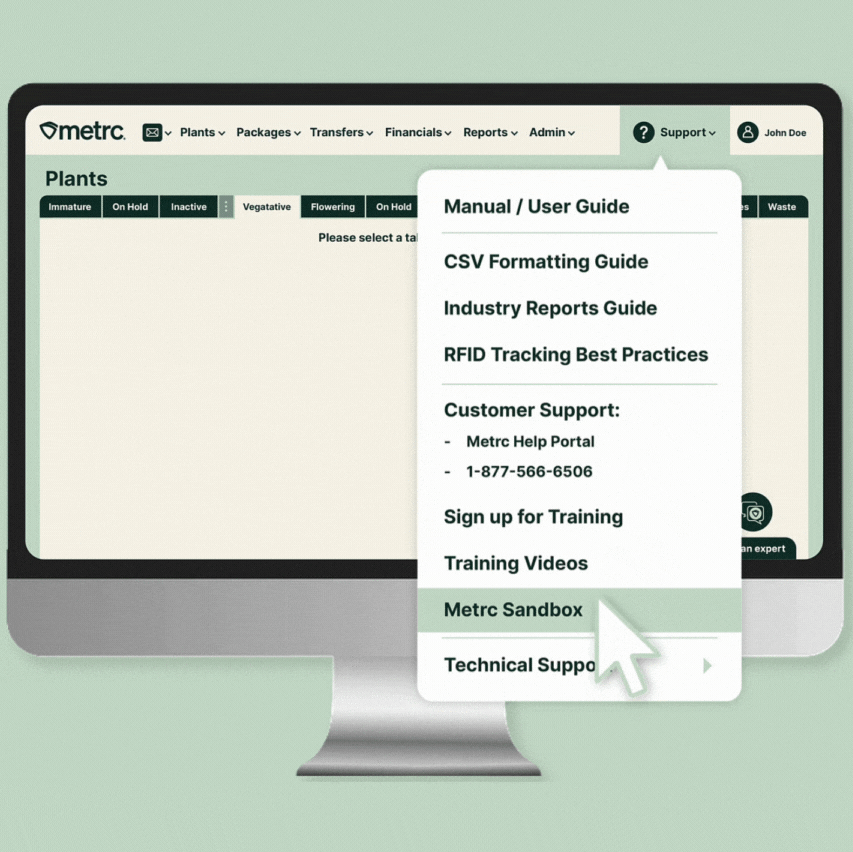A Certificate of Analysis (COA) gives people the real story behind a cannabis product. At Metrc, we believe every product should tell the truth about what is inside. A COA is a report from a licensed third-party testing facility that verifies safety, potency, and quality. It protects consumers and supports transparency across the market.
Many shoppers look at the product label and may think that is all the information they need to know. The reality is that labels can miss important details or even misstate cannabinoid levels. Without a COA, there is no way to know if a product meets safety standards or if it is free from harmful contaminants.
What to look for in a COA
The first section to check is the product and sample information. This part includes the product name, batch or lot number, the date the sample was taken, and the name of the licensed laboratory that conducted testing. These details help match the COA to the exact product in hand.
The cannabinoid profile comes next and is valuable in helping people choose products that suit their needs. It shows how much THC (better known for its psychoactive effects) and CBD (a compound in cannabis that may offer benefits like pain relief with no or low psychoactive effects) are in the product along with other cannabinoids, such as CBG or CBN.
Some COAs include a terpene profile. Terpenes are natural compounds that shape the smell, taste, and potential effects. Myrcene, for example, may offer a more relaxing feeling, while Limonene brings a citrus scent and may feel more uplifting. Pinene can create a pine-like aroma and may promote alertness.
The contaminant testing section is a key and vital part of the COA. It covers microbes such as E. coli and Salmonella, heavy metals like lead and arsenic, pesticides, and residual solvents in concentrates. Each test result should say PASS to show that the product is safe for use.
For flower products, moisture content and water activity are included. Proper levels help prevent mold and keep the product fresh. Too much moisture can lead to mold while too little can make the product harsh and dry.
COAs also check for mycotoxins and foreign materials. These tests confirm that the product is free of toxins and unexpected particles that could pose health risks. A safe product will always show a PASS in these sections.
Understanding the information included on a COA helps consumers make informed choices based on their personal preferences or medical needs, whether that’s finding a terpene profile that fits their desired effects or confirming purity standards.
The problem with labels alone
While a cannabis product label provides basic details like THC percentage, strain name, and weight, it only tells part of the story. A COA offers the full picture. This lab-issued document breaks down the product’s complete chemical profile and verifies that what’s in the package actually matches what’s on the label, providing transparency and safety assurance.
Many studies have shown that product labels do not always match laboratory testing results. Some products contain more THC than advertised. Others list CBD amounts that are much higher than what is actually present.
In short, the label is a summary; the COA is the evidence behind it. Responsible brands make their COAs easy to access because informed consumers deserve more than marketing claims, they deserve data.
How Retail ID makes it easier
Reading a COA can feel technical and overwhelming, especially for new consumers. Retail ID makes that process easier by linking the product to real lab test results. And with a single scan of the QR code on a mobile phone, that experience becomes instant and interactive.
Once scanned, COA data is easy to understand and use. Just scan the Retail ID QR code on the product packaging or label, and verified test results directly from the state traceability system are instantly available. No digging through PDFs or rummaging through printed copies. No guesswork. Just clean, trusted data in seconds.
A smarter way to view COAs
In a single scan, a typical COA transforms into a streamlined, user-friendly format:
- Clear potency display, including total THC, CBD, and minor cannabinoids like CBN
- Visual terpene charts to show what makes the product unique
- Direct lab data, with batch numbers and lab IDs linked to the product
It turns test results into something real people can actually use, whether shopping in-store or learning more at home.
More than transparency: It’s trust
By connecting verified test results to the product itself:
- Consumers feel more confident about what they’re using
- Retailers enjoy faster intake, smoother checkout and turnkey customer education
- Brands stand out by showing proof of quality and compliance
It’s a shared benefit across the entire supply chain, creating a safer, more transparent legal cannabis market.
Accessing the COA through Retail ID
Retail ID uses QR codes on finished goods packaging so anyone can scan and see the actual COA right away. Instead of searching a website or asking staff for a copy, the information is in consumers’ hands within seconds.
When viewing a COA, the data is presented clearly and in a way that is easier to understand. Cannabinoid percentages, terpene details, and safety results are displayed in a straightforward format.
Retail ID also supports better compliance for dispensaries by keeping product information consistent across inventory systems and sales records. This consistency helps maintain regulatory standards and avoids potential errors.
Most of all, Retail ID builds trust. When customers can easily see and understand what is in a product, they feel more confident in their choices. This openness strengthens relationships between consumers and the licensed businesses that work hard to deliver quality products.

Why Reading a COA Matters
Understanding a COA helps everyone in the market. It empowers buyers to make informed choices and supports safe use. It also pushes producers and dispensaries to stay honest and transparent.
At Metrc, we believe that clear and easy access to COAs is essential. Retail ID helps bridge the gap between complex lab results and everyday shoppers. It turns technical data into simple, actionable information.
Final Thoughts from Metrc
A COA is more than a document. It is a promise to consumers that a product is safe and accurately represented. By learning how to read a COA and using tools like Retail ID, people can shop with more confidence and clarity.
At Metrc, we’re proud to support the cannabis industry with technology that makes transparency easier for everyone.


